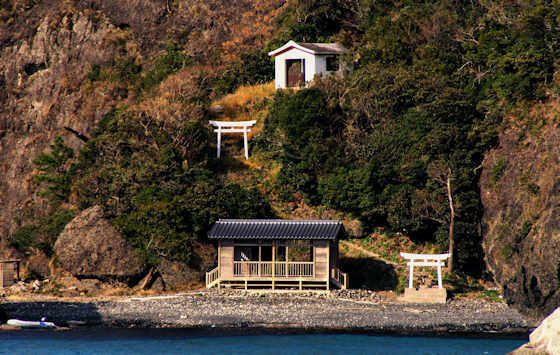Karashima
Just offshore from the harbour entrance at Takuno near Niima in Shimane is a small group of islets, the largest being called Karashima. Karashima has a shrine named, not surprisingly, Karashima Shrine, and the main kami enshrined here are Susano and his son Isotakeru.
According to the local legend, the island is the stone boat that Susano and his son sailed in from the Korean Peninsula to settle in Izumo. According to the most common version of Japanese mytho-history, the one in the Kojiki, Susano was kicked out of heaven and immediately descended to Izumo. However, in the Nihon Shoki, which was the official version of history before the Kojiki was revived in modern times, Susano descended to the
Korean Peninsula before heading to Izumo. I did read in one medieval text that Susano was believed to have been a prince from the kingdom of Silla. The same text also said Jimmu came to Japan from what is now Okinawa.
I was surprised to find a new statue of Susano in the town. Happily, it was not in the sickly-cute anime style of so many renditions of ancient myths nowadays, but rather as Susano appears in the local Iwami Kagura form of defeating Orochi.
I have not yet made it out to the island to visit the shrine, but discovering it and the associated story set me off on years of exploration and research into the various origin stories of Susano. I had always believed this was a purely local version, for instance up in Okuizumo their story has Susano descending from heaven to a rock near the Hi River. However, a few years ago while on a boat trip out of Nagato on the north coast of Yamaguchi, the tour guide mentioned that Nagato was where Susano used to depart on his trips back to Korea.
Just around the headland from Karashima is the village and port of Isotake, named after Susano's son. The shrine records there say that Susano used to regularly travel back and forth between Japan and Korea.
Design your own happi coat






























































